#magnetic resonance
Explore tagged Tumblr posts
Text
MAGNETIC RESONANCE
i'm coming to terms with a new disability.
on tuesday, while i lay quietly in a screaming tube that temporarily realigned the water particles inside my body, i had time to let my mind wander.
so...

announcing it here. hoping to have it done by the weekend.
9 notes
·
View notes
Text
Club Furies Premiere: Gonzalo MD - Transversal Object [Dynamic Form]
Dynamic Form presents its new gem, this time led by Buenos Aires-based Argentinian producer and artist Gonzalo MD. It’s titled Magnetic Resonance and is made up of two original tracks – the eponymous track and Transversal Object – and two remixes by MPak and Drop-E. Magnetic resonance is a non-invasive imaging technology that produces detailed three-dimensional anatomical images without the use…

View On WordPress
#Argentina#Buenos Aires#club furies#Dark#Deep#Dynamic Form#Electronic#Electronica#Gonzalo MD#Hypnotic#industrial#Magnetic Resonance#Premiere#Raw#Spain#techno
0 notes
Text
The Brain, Head, and Neck Category To Observe Fastest Growth In The MRI Systems Industry
The global MRI systems market value will reach USD 14,880 million by 2030 from USD 8,924 million in 2022, at a 6.60% CAGR. This can be credited to the technological improvements in magnetic resonance imagery, raising awareness of the initial finding of illnesses, growing government aid for MRI, growing occurrence of chronic illnesses, and rising elderly populace. Based on architecture, MRI…

View On WordPress
0 notes
Text
How Does the Brain Work?
First, a confession. I don’t know. Probably neither does anyone else, but Pang et al. (Nature https://doi.org/10.1038/s41586-023-06098-1 ) have come up with an unusual concept. The anatomy of the brain clearly constrains its function, but exactly how does this happen? The usual paradigm is that neuronal dynamics are driven by interactions between discrete, specialized cell populations connected…
View On WordPress
0 notes
Text

#Lung cancer is #diagnosed through #imaging tools, including #computedtomography (CT), #magnetic resonance #imaging (MRI) and #positron emission tomography (PET)
#drshikharkumar#consultantmedicaloncologist#oncologist#CancerCare#cancertreatment#bestoncologist#MedicalOncologist#Hyderabad#diagnosis of#Lung cancer#imaging tools#computedtomography (CT)#magnetic resonance#imaging (MRI) and#positron emission tomography (PET).
0 notes
Text
MIT physicists and colleagues report new insights into exotic particles key to a form of magnetism that has attracted growing interest because it originates from ultrathin materials only a few atomic layers thick. The work, which could impact future electronics and more, also establishes a new way to study these particles through a powerful instrument at the National Synchrotron Light Source II at Brookhaven National Laboratory. Among their discoveries, the team has identified the microscopic origin of these particles, known as excitons. They showed how they can be controlled by chemically "tuning" the material, which is primarily composed of nickel. Further, they found that the excitons propagate throughout the bulk material instead of being bound to the nickel atoms.
Continue Reading.
68 notes
·
View notes
Text
By popular (???) request, based on the outcome of this poll.
A WARNING: you guys really did pick the most complex one. This is loooooong. A DISCLAIMER. This is a silly little lesson aimed at folks who know sod-all about MRI. There are memes. There is (arguably) overuse of the term ‘big chungus’. If you are looking to delve deeper into the mysteries of K-Space, this is not the Tumblr post for you.
So, without further ado...
Today I am introducing you to my one true love. The legend. The icon.
Ferromagnetic material loves him. Claustrophobic people fear him.
Yeah, that’s right – we’re talking about the big boom-boom sexyboy magnet machine, hereby known as Big Chungus.

Aka...
MAGNETIC RESONANCE IMAGING
First off, though? Let’s start small.
Very, very small.
Meet HYDROGEN.

The nucleus of this element is made up of a single proton, which has a magnetic dipole – i.e., it acts like a tiny bar magnet.
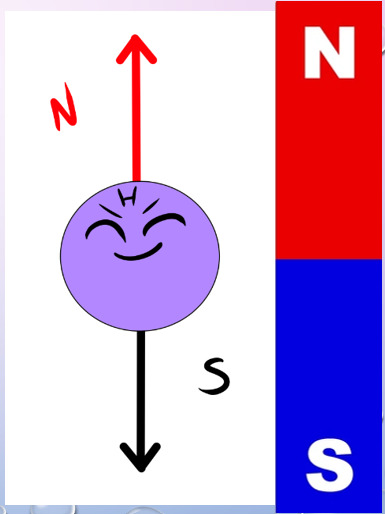
Hydrogen is also a component of water. As we all know, we’re basically walking sacks of goop – meaning that Hydrogen is abundant throughout our bodies.
Therefore, when we stick you in a strong magnetic field… say, within our friend Big Chungus… we can manipulate all those tiny Hydrogen atoms in a variety of fun ways.

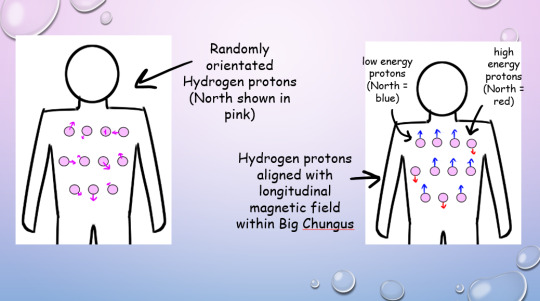
Under normal conditions, all your Hydrogen protons are pointing every-which-way.
But in Big Chungus, there is a strong longitudinal magnetic field that travels along the Z-axis of the machine. So, all your teeny tiny Hydrogen protons swivel to align with that field!
If a proton’s energy is LOWER than that of the longitudinal magnetic field (a majority), they will align PARALLEL with the field. If their energy is HIGHER (a minority) they will align ANTI-PARALLEL.
As most of the protons align with the longitudinal magnetic field, the net magnetisation vector within the human body is also longitudinal! This is called the thermodynamic equilibrium – the resting state for all those li’l protons when your body is within Big Chungus.
(You won’t feel any different, btw! We’re flipping a bunch of teeny-tiny bits inside you, but you won’t feel a thing!) (You might do later, when we activate the Gradient coils. We’ll….. get to that)
But, while all of this is very cool, it gives us no actual information. We gotta play some more with your protons - which brings us to arguably the most important concept in MRI. I mean, it’s literally in the name!

Let’s go back to our Hydrogen protons.

We’ve established that they’re all pointing in different directions. But they’re not just sitting still. They’re spinning and wobbling all over the shop.
We call this rotational wobbly movement precession.
In their natural state, these protons all precess at different speeds. When we subject them to Big Chungus, as well as all lining up neatly with the magnetic field, they all start to precess at the same speed.
However, their magnetic North will be pointing to different points at any given moment. Imagine two clocks, both of which are ticking at the same rate, but which have been set to read different times.
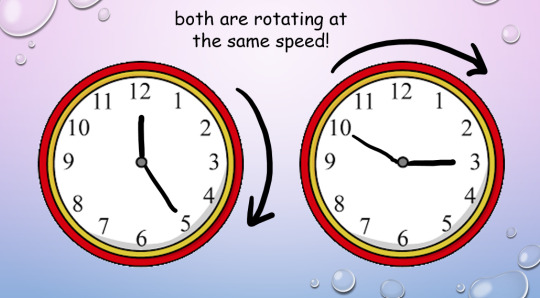
This is where magnetic resonance comes in.
In addition to the homogenous longitudinal magnetic field provided by Big Chungus, we also create an oscillating magnetic field in the transverse plane by using a radiofrequency (RF) pulse. We can tune that oscillation to the ‘resonant frequency’ of Hydrogen atoms.
Every molecule capable of resonance has its own specific frequency. We use a funky equation called the Larmor Equation to work this out, or, as I like to call it, W, BOY!!!
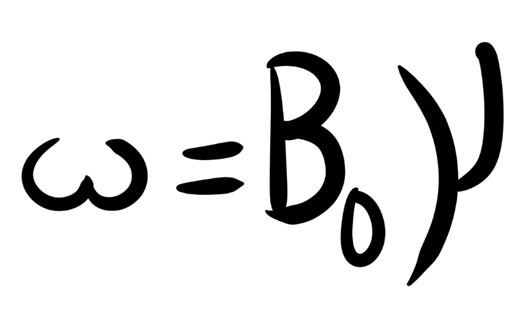
(The weird ‘w’ is the resonance frequency; the weird ‘Bo’ is the magnetic field strength, and the weird ‘Y’ is the gyromagnetic ratio of each particular element.)
So, we know exactly at what frequency to apply that RF pulse to your protons, to achieve resonance!
But what is resonance?

In acoustics, a ‘resonant frequency’ is the frequency an external wave needs to be applied at in order to create the maximum amplitude of vibrations within the object. Like when opera singers shatter glass with their voice! They’re singing at the resonant frequency of the glass, which makes it vibrate to the point where it compromises its structural integrity.
A similar concept applies in magnetic precession, with, uh, less destructive results. We’re not exploding anything inside of you, don’t worry!
(We do explode your innards accidentally in Ultrasound sometimes, via a different mechanism. But you’ll have to ask me more about that later. >:3)
To put it simply, magnetic resonance is the final step in getting those protons to BEHAVE. Now, the clocks have been corrected so their hands move at exactly the same time, in the same position. The protons are precessing ‘in phase’. Yay!
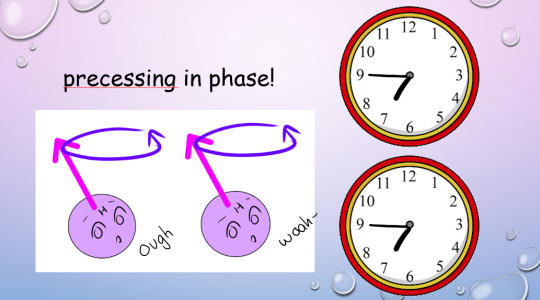
This creates transverse magnetisation, as the magnetic vectors of all those protons (which, remember, act as bar magnets) will swing around to point in one direction at the same time.
But the cool thing about resonance? It also allows the protons to absorb energy from the RF pulse.
(Do NOT ask me how. Do NOT. I will cry.)
And remember how the higher-energy protons flip anti-parallel to the longitudinal magnetic vector of Big Chungus, while the lower-energy protons are aligned parallel? And because we have more low-energy protons than high-energy protons, our body gains a longitudinal magnetic vector to match Big Chungus?
Zapping those protons at their resonant frequency gives 'em energy (a process known as ‘excitation’, which I love, because I get to imagine them putting little party hats on and having a rave).
So, loads of them flip anti-parallel! Enough to cancel out the net longitudinal magnetic vector of our bodies – despite the best efforts of good ol’ Chungus!
(Keep trying, Chungus. We love you.)

Our protons are as far from our happy equilibrium as they can possibly be. We’ve lost longitudinal magnetisation, and gained transverse magnetisation. Oh noooo however can we fix this ohhhh noooooo
Simple. We turn off the RF pulse.
Everything returns to that sweet, sweet thermodynamic equilibrium.
Longitudinal magnetisation is regained. I.e., the protons realign with Big Chungus’s longitudinal magnetic field, with the majority aligned parallel rather than anti-parallel.
This is called SPIN-LATTICE RELAXATION.
‘T1 time’ is the point by which 63% of longitudinal magnetisation has been regained after application of the RF pulse. A T1-weighted image shows the difference between T1 relaxation times of different tissues.
And, without that oscillating RF pulse, we lose resonance – the protons fall out of phase randomly, due to the delightful unpredictable nature of entropy, and Transverse magnetisation reduces.
This is called SPIN-SPIN RELAXATION.
Or, if we’re feeling dramatic…

‘T2 time’ is the point by which 37% of the transverse magnetisation has been lost. A T2-weighted image shows the difference between T2 relaxation times of different tissues.
(Spin-spin is objectively a hilarious phrase to say in full seriousness when surrounded by important physics-y people. However, a word to the wise: do not make a moon-moon joke. They are not on Tumblr (present company excluded). They will not understand. You will get strange looks.)

But remember how resonance lets our protons shlorp up that sweet, sweet energy from the RF pulse? Well, in order to get back to thermodynamic equilibrium and line up with Big Chungus again, they have to splort that energy back out.
This is why we stick a cage over the body part we’re imaging. That cage isn’t a magnet, or a way of keeping you still – it’s a receiver coil.
It picks up the RF signal that’s given off by your innards as they relax from the intense work-out we just put them through. How cool is that??

The amount of time we wait between applying the RF pulse and measuring the ‘echo’ from within your body is called the ‘ECHO TIME’, or ‘TE’ (because we didn’t want to call it ET).
(yes, we’re cowards. Sorry.)
We also have ‘REPETITION TIME’ or ‘TR’ – the amount of time we leave between RF pulses! This determines how much longitudinal magnetisation can recover between each pulse.

By manipulating TE and TR, we can alter the contrast (i.e., the blacks and whites) on our image.
Areas of high received signal (hyperintense) are shown as white, while areas of low received signal (hypointense) are shown as black. Different sorts of tissue will have different ratios of Hydrogen-to-other-shit, and different densities of Hydrogen-and-other-shit – ergo, some tissue blasts out all of its stored energy SUPER QUICK. Others give it off slower.
A T1-weighted image has a short TR and TE time.
Fat realigns its longitudinal magnetisation with Big Chungus SUPER QUICK. This means, on a T1-weighted image, it looks hyperintense. However, water realigns its longitudinal magnetisation with Big Chungus slooooowly. Therefore, on a T1-weighted image, fluid looks hypointense! Ya see?
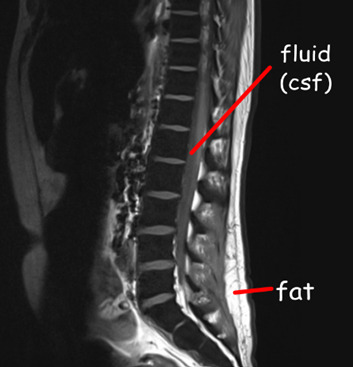
A T2-weighted image has a long TR and TE time.
The precession of protons in fat decays relatively slow, so it will look quite bright on a T2-scan. But water decays slower, and therefore, by the time we take the T2 image, fluids within the body will be giving off comparatively ‘more’ signal than fat – meaning they’ll appear more hyperintense!
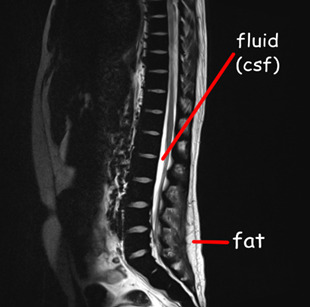
If we have a substance with intrinsically long T1 and T2 values, it will appear dark on a T1-weighted image and bright on a T2-weighted image, and the same in reverse. If a substance has a short T1 value and a long T2 value, it will appear relatively ‘bright’ on both T1 and T2-weighted images – i.e., fat and intervertebral discs.
As every tissue has its own distinct T1 and T2 property… we can work out precisely what sort of tissue we’re looking at.
When we build in all our additional sequences, this becomes even clearer! This is why your MRI scan takes sooooo long – we’re running SO MANY sequences, manipulating TR and TE to determine the exact T1 and T2 properties of various tissues within your bod.


There is, however, a problem.
The RF signal given off by each proton doesn’t shoot out in a handy-dandy straight line. Meaning, we have no idea where the signal is coming from within your body.
Enter our lord and saviour:
THE GRADIENT COILS.
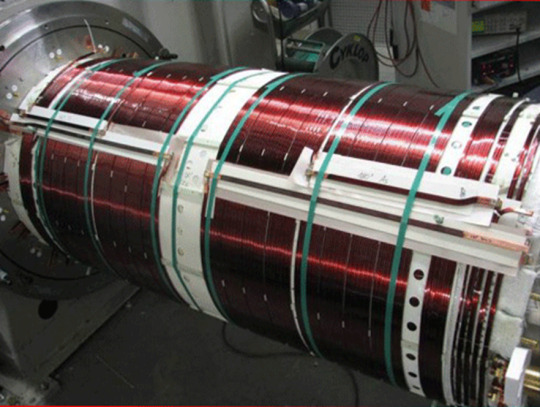
(Shim coils are also very important – they maintain field homogeneity across the whole of Big Chungus. While Big Chungus wouldn’t need them in a perfect theoretical scenario… reality ain’t that. Big Chungus’s magnetic field is all wibbly-wobbly, so we use Shims to keep everything smooth! That’s all you need to know about them. BACK TO THE GRADIENTS.)
There are three of them, wrapping around each of the three planes of your body. When these activate, they cause those epicly eerie booming noises, characteristic of a Big Chungus ExperienceTM.
youtube
The Gradient coils are also what causes those weird tingling sensations you get in an MRI machine – which, don’t worry, aren’t permanent! Your nerves just go ‘WOAHG. THASSALOT OF MAGNET SHIT. HM. DON’T LIKE THAT.’ But they’ll calm down again once you’re freed from Big Chungus.
The gradient coils cause constant fluctuations in the magnetic field across all three dimensions. They activate sequentially, isolating one chunk of your body after the next.
As these fluctuations cause variation within the signal received, we can look at how much THAT particular signal, received at THAT particular number of milliseconds after an RF pulse, varied when THAT particular gradient was activated, in comparison to when THAT OTHER gradient was activated.
For every single bit of signal output.
That gives us A WHOLE LOTTA DATA.

^ imagine this, but the cupboard contents is just. data.
Way too much data, in fact, for our puny human brains to comprehend – so obviously, we feed it to an algorithm.
K-space is a funky computational matrix where all this info gets compiled during data acquisition. Once we’ve finished the scan sequence and have all that yummy raw data, it can be mathematically processed to create a final image!
Just like that. Simple, right?

TL;DR
You are full of Hydrogen.
Hydrogen nuclei (protons) are basically tiny magnets
These tiny magnets are orientated completely randomly, with ‘North’ pointing in all directions
We stick billions of these tiny magnets (i.e., you) into a mahoosive magnet (i.e., Big Chungus)
All the tiny magnets flip around to align with the longitudinal magnetic field of Big Chungus
High energy protons = antiparallel Low energy protons = parallel
As you have more low energy protons than high energy protons in your body, the net magnetic vector of your body is longitudinal – just like Big Chungus!
All your protons are spinning and wobbling (precessing) at random rates
We use an RF pulse, tuned to the Resonance Frequency of Hydrogen, to make ‘em precess in phase (wobble at the same time, all pointing in the same direction at once). This creates a Transverse magnetic vector.
This in-phase precession is ‘Magnetic Resonance’
Magnetic Resonance means the protons can absorb energy from the RF pulse
Now there are more high energy protons within your body! They flip antiparallel, and the net longitudinal magnetic vector of your body decreases.
We measure the time it takes for the high-energy protons to release that energy and return to alignment with the net magnetic vector of Big Chungus (Spin-Lattice Relaxation / T1 recovery)
And the time it takes for the precessing-in-phase protons to Quit That Nonsense and all start wobbling in random directions again (Spin-Spin Decay / T2 recovery)
Each tissue within your body has a different composition & density of Hydrogen atoms – which means each tissue within your body has a unique T1 & T2 recovery time
By measuring the signal at different times (TE) and by varying the frequency with which we apply RF pulses (TR), we ‘take pictures’ that show variations in the amount of signal these tissues are giving off. The signal is caught by the large radiofrequency receiver coils we put over you when you enter the machine.
Because the signal given off during recovery/decay blasts out in all directions, we don’t know exactly where it originated within your body.
Gradient coils are arranged across X, Y, and Z axes throughout the gantry of Big Chungus. They cause tiny fluctuations in the magnetic field, in sequential chunks throughout space. This is the booming noise you hear when you’re in the machine.
These tiny fluctuations cause variations in the signal we receive, depending on how close the signal is to the activated gradient coil. All this data is compiled in a magical computational matrix called K-space. A funky algorithm then decodes those variations and couples them up with the strength of the signal to give us 1) How much signal is being blasted out at that particular moment 2) Where exactly that signal comes from within your body, according to the 3D map produced by the gradient coils
It then represents these values with a pretty picture!
Tl;dr tl;dr:

69 notes
·
View notes
Text
why do they play music for you in the mri if they never play it loud enough to be heard over the beeping and banging???
20 notes
·
View notes
Text
Induction
Hearts beat at synchronous speeds,
A magnetism between strangers.
Connections among stars and sea,
And a heightened sense of danger.
-
We observe with eyes of old,
Remembering all we see.
Nature replies with love so bold,
And the resonance between leaves.
#writerscreed#poetryportal#poem#poetry#writers of tumblr#thoughts#writer#insominia#spilled ink#insomnia poetry#love#magnetism#magnetic#nature#resonance#leaves#stars#sea#induction#maintenance#man and machine#syncronicity#hearts
26 notes
·
View notes
Text
Guess who's over and done with the MRI? I am! It was torture. I wish I didn't have to drink the stinky water. I'm so sick from it. I get my results in like 3 days. Wish me luck.
-Amber (she/they/it/star/shine/rot)
#disability#disabled#actually disabled#chronic illness#chronically ill#ibd#inflammatoryboweldisease#inflammatory bowel disease#mri#magnetic resonance imaging
11 notes
·
View notes
Text

Scientists use NMR spectroscopy to map polyelectrolyte distribution and solve a century-old chemistry riddle
When two solutions of oppositely charged polymers (polyelectrolytes) are mixed, phase separation occurs and leads to the formation of a polymer-rich phase and a supernatant phase. The precise distribution of all components, that is polyelectrolytes and counterions, had not yet been determined. Researchers at the University of Twente can now measure quantitatively exactly where these components are distributed using nuclear magnetic resonance (NMR) spectroscopy. For more than 90 years, chemists have been fascinated by polyelectrolyte complexes that form after solutions of two oppositely charged polymers are mixed. A better understanding of these complexes is crucial for the development of materials based on these complexes.
Read more.
#Materials Science#Science#Spectroscopy#Nuclear magnetic resonance#NMR#Polymers#Chemistry#University of Twente
13 notes
·
View notes
Text
The biggest mystery in the XMCU isn't how Darwin managed to die in First Class, but how Wolverine survived being put in what is essentially a big, magnetic tube without his skeleton getting ripped from his body.

#wolverine#xmen#x men movies#hugh jackman#mri#Mris are just giant magnets#magnetic resonance imaging#Marvel explain#Is it a magic mri machine?#How did the machine not explode?#You can't have metal in an MRI#i'm loosing my mind
20 notes
·
View notes
Text
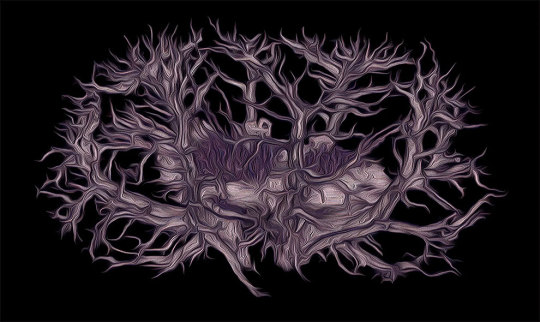
Scientists use magnetic resonance microscopy as a non-invasive MRI method to visualise internal organs. This spiky-looking specimen is actually a rat kidney.
Photograph: Gary Cowin/AIBN
2023 Australian Institute For Bioengineering And Nanotechnology Image Contest
#gary cowin#photographer#australian institute for bioengineering and nanotechnology image contest#magnetic resonance microscopy#micro photography#internal organs#rat kidney#nature
13 notes
·
View notes
Note
lots of touhou asks today so i will mix things up. what class would you be in fire emblem.
Mage fighter, as always. The (not-yet-extant) version with dark magic, obviously.
#i can use swords but i'm only okay at it#and i read a lot. but generally things man was not meant to know#if i must choose an extant class i get dark mage by default since “nuclear magnetic resonance is black magic”#and i'm certainly not promoted yet
18 notes
·
View notes
Text
“I love not being able to understand anything I’m seeing, thank you, Magnetic Resonance!”
16 notes
·
View notes
Text


#Its great to support such projects like this;#we always teach people about health concept but we face alot of challenges during this course#we lack tools eg medicine#phones#computers#Quantum resonance magnetic resonance magnetic analyzer#projectors#clothes to wear during work#we need buildings to make hospitals and to make shelter for the needy families#these are the reports we get from people after feilds kidney stones people are always affected with kidney stones#diabetes high cholesterol in blood blood clots#intestinal cancer#lgbtq#lesbians#bixesual#mtf#ftm#queer#trans
2 notes
·
View notes